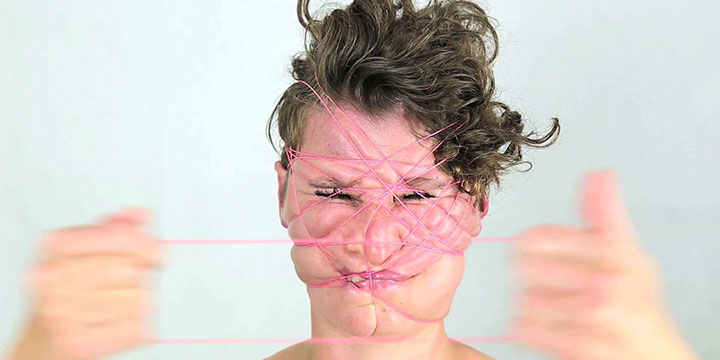Galerie Jocelyn Wolff
78, rue Julien-Lacroix
F-75020 Paris
T + 33 (0)1 42 03 05 65
www.galeriewolff.com
January 10 - February 14, 2015
The Doctor never leaves the house. Walking is a major effort for him. He’s big and stout, and his legs are shaky. Even at home, he rarely budges from his armchair. Most of the time he sits at his desk, sipping brandy and gazing out the window at whatever happens in the village. He watches and takes notes. He writes and sketches. His drawings are simple yet precise, perspective renderings of what the Doctor sees from his window. They put order into the chaos of what lies outside: the mud, the animals roaming through the streets, the hanky-panky, the scheming, the money changing hands.
The Doctor is a character from Béla Tarr’s film Sátántángo . I thought of him as I watched the videos that Zbyněk Baladrán has shot using a fixed camera pointed at a tabletop. On it, two hands draw diagrams, write words, cut geometric shapes from sheets of paper, stack books. Sometimes the images are accompanied by a voiceover, like the Narrator in Sátántángo. The voice comments on what the hands are up to, or else ponders universal questions: the number of instants making up a life, the structure of society, the structure of reality. These are obsessive, solipsistic monologues. Reasonings that follow a logical thread, ignoring how this thread leads them, step by step, into a sphere of abstraction that no longer bears any resemblance to the world we know.
The Czech artist’s videos serve as mileposts throughout the program. Between them, other images flow: videos by Katinka Bock, Guillaume Leblon, Ulrich Polster, Clemens Von Wedemeyer. I suggest imagining, as one watches, that the nameless, faceless character in Baladrán’s videos has lifted his eyes from the table and is looking out the window, like the Doctor in the film by Béla Tarr. What he sees, what we also see, often seems incomprehensible. A man walks around a room whose floor is covered in mud. Objects come flying out the windows of a country house. In a dimly lit room, in the heart of a deserted, snowbound neighborhood, a TV set shows an Italian movie from the Sixties. Effects whose causes we do not know, causes whose effects we will not see. In choosing the videos, I tried to put myself in the position of someone seeing them for the first time, who knows little or nothing about the artists who made them. In some cases this was not hard at all; I really was seeing the videos for the first time, and I really did know little about the artists. I held onto this ignorance. I did my best to look at these images in and of themselves, like views of the world paraded before us, each bearing its own strangeness, and disappearing as mysteriously as they appear.
Since the liquor has run out and his maid seems to have vanished, the Doctor is eventually forced to leave the house. His long wanderings through the muddy streets of the village culminate in a terrible collapse. He is taken to a hospital in the nearest town. When he comes home, some time later, he settles down in front of the usual window, opening his notebook. He patiently waits for someone to come by. Time passes, no one in sight. They must be gathered somewhere in the village, plotting, fornicating, stealing each other blind, the Doctor thinks. They’ll turn up.
What the Doctor doesn’t know is that the inhabitants of the village have all gone away, lured by a swindler’s false promises of work. No one is left, not a soul. But he waits, pen in hand, notebook open. He waits for someone, or something, to appear in the space framed by the window.
And we wait with him.
Zbyněk Baladrán
Night of the World, 2010, video, with Czech audio and English subtitles, 4:04 min
The film begins in darkness. A voice is heard questioning the moment of creation, this unpredictable moment connecting a before and an after, between the darkness and the light. The film ends in darkness.
Guillaume Leblon
Notes, 2007, video, color, sound, 7:22 min
In a mixture of water and dirt, Notes captures the landscape that infiltrates the artist studio. The camera records the state of the matter, the image becomes like a fossilized memory.
Zbyněk Baladrán
Moment, 2007, video on DVD, in Czech with English subtitles, 4:14 min
The moment that is being questioned is the emergence of language, the the words themselves as matter that come about through the process of writing. The hand returns to the center of the image, writing is a manipulation. The commentary replicates the writing gesture, reading each word aloud, one by one.
Ulrich Polster
Frost, 2003, 2004, video, 5:19 min
The night city. Industrial ruins filmed in contre-jour. Memories from childhood. Different places and times combined at the mountain. It is a hollow portrait of Eastern Europe that carries the traces of its history.
Zbyněk Baladrán
Model of the Universe, 2011, video, color, sound, in English with French subtitles, 2:50 min approx.
To visually transpose a theoretical discourse, the method of the film borrows its vocabulary from graphic design logic. The graphics and geometrical shapes follow, one after another. Rather than the visual products and results, the film takes an interest in the process, the gesture itself and the trajectories in movement.
Katinka Bock
Raus I + II, 2006, Raus I, super 8, black and white, 0:24 min, Raus II, dv, black and white, 0:32
A study on landscape and a reflection on movement.
Zbyněk Baladrán
The Long-ago Death of a Fly, 2010, HDV, color, sound, audio in Czech with English subtitles, 3:16 min
A methodology of writing related through the flight of a fly. Guided by the nervous trajectory of the insect, the film functions as an epistemological form where the theoretical discourse visually translates through a method, a gesture.
Clemens von Wedemeyer,
Silberhöhe, 2003, 35mm transferred to DVD, 10 min
In Halle-Silberhöhe in East Germany, the camera records peri-urban area architecture, prefabricated buildings that are deserted and destined to be demolished. The commentary evokes a film editing technique used by Michelangelo Antonioni in his film, L’Eclisse (1962).
Zbyněk Baladrán
All for no reason , 2011, HDV, color, sound, with Czech audio and English subtitles, 4:06 min
The artist films himself in a space under construction. In the background, workers are busy with their work. Zbyněk Baladrán reads a dialogue between two fictive characters whose intonations become absurd; all communication is in peril, all meaning suspended. The noise from the construction work parasites and contaminates the dialogue.



































